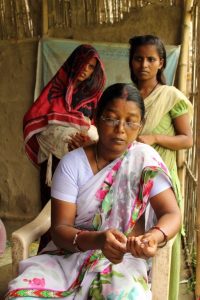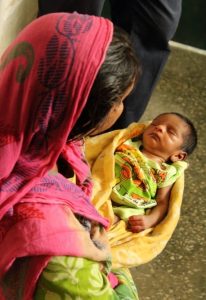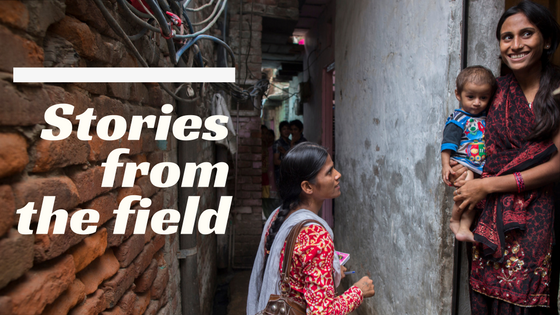Possible serious bacterial infection (PSBI), or neonatal sepsis, is a major cause of mortality among young infants in India, contributing to 33% of neonatal deaths.[1] The Government of India (GOI) launched operational guidelines in 2014 for use of injection gentamicin by auxiliary nurse midwives to manage sepsis in young infants where referral is not possible. The Saving Newborn Lives program partnered with CARE-India on a pilot in Saharsa district in Bihar to learn what is required to properly implement a combination of facility- and community-based interventions for sepsis management. The project trained public health service providers at all levels to identify, refer and treat cases of sepsis in young infants. Following are two stories that the project team gathered as part of this implementation learning process.
The role of nurse-midwives in managing sick young infants with sepsis in India
Reena saw that her week-old daughter Arushi had fever, pustules on her body, and was not being able to breastfeed. She took the baby to Asha Kumari, an auxiliary nurse midwife, or ANM,[2] who identified it as “possibly severe bacterial infection,” or PSBI. She weighed the newborn, administered an injection of gentamicin (an antibiotic), and gave a bottle of amoxicillin syrup (an oral antibiotic), to Reena with instructions on how to give the medicine. She filled out a treatment card with the details and asked Reena to take the card with her to get the remaining six doses at the primary health center (PHC).
Asha Kumari has been with the Arsi Health Sub-centre in Sonbarsa block, District Saharsa for the last 10 years. She attended a one-day orientation, along with her colleagues from the block, on the new guidelines launched by Government of India that allow ANMs to administer injectable gentamicin for management of sepsis in young infants where referral was not possible. The orientation refreshed her knowledge on the symptoms of sepsis. She learned to calculate the correct dosages of the antibiotics and to counsel caregivers.
“Now I know that a newborn may have PSBI if he or she is cold to touch, is unable to breastfeed, or has less than normal movements,” she said.
Asha Kumari started playing audio messages during village health and nutrition days (VHNDs). A woman came up to her and requested her to visit her nephew who had some of the symptoms mentioned in the messages. Asha Kumari made a note in her diary to make the visit. She would like to conduct more home visits to newborns, but she feels that there is lack of time after the routine immunizations and counselling at VHSNDs.

She would like the ASHAs in her area to proactively tell her about newborns in their villages and their health status so she can prioritize visiting those who require immediate attention. She leaves her mobile number with the parents of newborns she visits so she can be contacted if there is any emergency. She suggests that ASHAs should create more awareness at the household level on the symptoms of PSBI and to alert parents that it can be treated free of cost at the PHC or with ANMs.
“I used to feel awful when I couldn’t help newborns with symptoms of PSBI, because I neither had any medicine nor were we allowed to give them,” she said.
But now, she feels there is an immense change in attitudes toward the ANMs. “When the baby is cured the parents, their families and neighbors develop faith in the abilities of the ANM,” she says while injecting the third dose of gentamicin to Arushi, who returned with Reena after one dose at the PHC because it was not possible for Reena to go to the PHC every day.
She asks Reena if she is regularly giving amoxicillin to Arushi, enters details in the treatment card and asks her not to miss any dose for the next four days.
The role of accredited social health activists in managing sick young infants with sepsis in India
“I lost my three-day-old grandson to an infection a few years ago,” said Meena Kumari, an accredited social health activists, or ASHA,[3] during one of her monthly meetings. She said her grandson was not able to breastfeed and had severe chest in-drawings. Though she had attended home-based newborn care training, she did not remember that these were the symptoms of sepsis and thought a good massage with warm mustard oil would cure him. However, the symptoms worsened and she could not save his life, even after taking him to a private doctor.
Two years after this incident Meena Kumari now confidently identifies sepsis in young infants and refers them either to the auxiliary nurse midwife, or ANM, or to the primary health center. The home-based newborn care refresher training helped her appreciate the danger signs of sepsis as well as other topics like birth preparedness, essential newborn care, breastfeeding and management of low-birthweight babies.

“I am the first health service provider to see the baby in the village, so I have to be very attentive during PNC visits,” she says, adding “I can’t let another baby die under my watch.” Meena Kumari looks for the danger signs of sepsis very closely in every newborn.
“Weight is the first thing I check, and if the birthweight is low I ask the mother to give kangaroo care and breastfeed the newborn more frequently. If there are any symptoms of sepsis I counsel the parents and caregivers to immediately take the young infant either to the ANM or to the primary health center. Sometimes I even call the ANM to tell her about the symptoms and take the newborn and the mother/caregiver to her for a pre-referral dose of antibiotic. At times when the mother is not confident to go to the primary health center, I accompany her and help her with the paperwork.” As an afterthought she adds, “But my role does not end there. I check on the young infant regularly to see if the treatment is being followed and that there are no recurrence of symptoms.”
“Although I still feel bad about the incident with my grandson, I do this because I feel responsible towards my people,” Meena Kumari says. She works in a population of about 1000 and knows who has delivered a baby in her area. “Cleanliness is key to avoid infection of any kind. I ensure that the parents and immediate caregivers maintain cleanliness and know the symptoms of sepsis. I leave my mobile number with them, so they can call me if they see any symptom on the days I don’t visit.”
“My knowledge on home-based newborn care and sepsis is very new and fresh. Even now I forget some symptoms because I cannot read or write fluently and the books that we got are very lengthy. It would be great if the refresher training is conducted after some time so that we keep revising our knowledge.”
